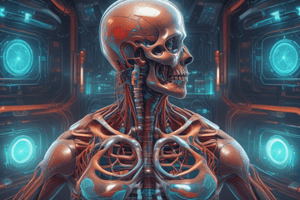Podcast
Questions and Answers
What is the primary purpose of external respiration?
What is the primary purpose of external respiration?
- To exchange oxygen and carbon dioxide between blood and body tissues
- To facilitate gas exchange between the lungs and the external environment (correct)
- To regulate the temperature of the air entering the lungs
- To produce sound through the vibration of vocal cords
Which process is primarily responsible for inhalation?
Which process is primarily responsible for inhalation?
- The diaphragm contracts and expands thoracic cavity volume (correct)
- The rib cage relaxes and expels air from the lungs
- The diaphragm relaxes and decreases thoracic cavity volume
- The diaphragm contracts and increases thoracic cavity pressure
What is the significance of ventilation-perfusion matching in the respiratory system?
What is the significance of ventilation-perfusion matching in the respiratory system?
- To balance airflow and blood flow for optimal gas exchange (correct)
- To enable quick expulsion of waste gases from the body
- To facilitate the absorption of nutrients from the air
- To ensure that all air entering the lungs is chemically pure
Which of the following is NOT a respiratory disorder?
Which of the following is NOT a respiratory disorder?
What role do the respiratory organs play in the process of respiration?
What role do the respiratory organs play in the process of respiration?
How does internal respiration differ from external respiration in terms of gas exchange?
How does internal respiration differ from external respiration in terms of gas exchange?
Which mechanism of breathing primarily focuses on the movement of air into the lungs?
Which mechanism of breathing primarily focuses on the movement of air into the lungs?
What determines the efficiency of ventilation-perfusion matching within the respiratory system?
What determines the efficiency of ventilation-perfusion matching within the respiratory system?
In what way might a respiratory disorder primarily affect inhalation?
In what way might a respiratory disorder primarily affect inhalation?
Which part of the respiratory organ track is primarily responsible for filtering and humidifying inhaled air?
Which part of the respiratory organ track is primarily responsible for filtering and humidifying inhaled air?
Flashcards are hidden until you start studying
Study Notes
External Respiration
- The primary purpose of external respiration is to exchange oxygen and carbon dioxide between the body and the external environment.
Inhalation
- Inhalation, or breathing in, is primarily driven by the contraction of the diaphragm, a large, dome-shaped muscle located below the lungs.
Ventilation-Perfusion Matching
- Ventilation-perfusion matching refers to the optimal balance between air flow (ventilation) and blood flow (perfusion) within the lungs.
- This matching ensures that the body receives adequate oxygen and removes carbon dioxide effectively.
Respiratory Disorders
- A respiratory disorder is any condition that affects the respiratory system, including the lungs, airways, and respiratory muscles.
- Common examples include asthma, pneumonia, and chronic obstructive pulmonary disease (COPD).
Respiratory Organs and Respiration
- The respiratory organs, including the nose, pharynx, larynx, trachea, bronchi, bronchioles, and alveoli, play a crucial role in respiration by facilitating the exchange of gases between the body and the external environment.
- This process involves four main steps:
- Pulmonary ventilation: The movement of air into and out of the lungs.
- External respiration: The exchange of gases (oxygen and carbon dioxide) between the alveoli and the blood.
- Gas transport: The transportation of oxygen and carbon dioxide between the lungs and the body tissues.
- Internal respiration: The exchange of gases between the blood and the body cells.
External Respiration
- The primary function of external respiration is to facilitate the exchange of oxygen and carbon dioxide between the lungs and the bloodstream.
Inhalation
- Inhalation is primarily driven by the contraction of the diaphragm, a large muscle that separates the chest cavity from the abdomen.
Ventilation-Perfusion Matching
- Ventilation-perfusion matching is crucial for optimizing gas exchange in the lungs. This process ensures an appropriate balance between airflow (ventilation) and blood flow (perfusion) to allow for efficient oxygen uptake and carbon dioxide removal.
Respiratory Disorders
- Respiratory disorders can encompass a wide range of conditions affecting the respiratory system. These disorders can disrupt normal breathing processes and impact overall health.
Respiratory Organs and Respiration:
- The respiratory organs, including the nose, pharynx, larynx, trachea, bronchi, bronchioles, and alveoli, work together to ensure efficient gas exchange during respiration.
Internal vs. External Respiration
- External respiration involves the exchange of gases between the lungs and the blood. In contrast, internal respiration is the exchange of gases between the blood and individual cells throughout the body.
Mechanism of Breathing: Inhalation
- Inhalation, the process of breathing air into the lungs, is primarily driven by the contraction of the diaphragm and the expansion of the chest cavity.
Efficiency of Ventilation-Perfusion Matching
- The efficiency of ventilation-perfusion matching is influenced by factors such as blood flow, airflow, and the distribution of these flows throughout the lungs.
Respiratory Disorders and Inhalation
- Respiratory disorders can directly affect inhalation by impacting the mechanics of breathing, potentially leading to difficulties taking in air due to airway obstruction, muscle weakness, or other factors.
Filtering and Humidifying Inhaled Air
- The upper respiratory tract, particularly the nasal passages, plays a vital role in filtering and humidifying inhaled air. This process helps to remove dust, particles, and pathogens, while adding moisture to the air to prevent drying out of the airways.
Studying That Suits You
Use AI to generate personalized quizzes and flashcards to suit your learning preferences.




